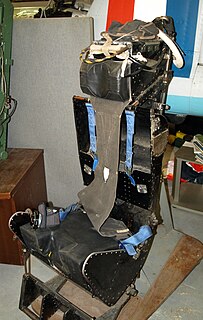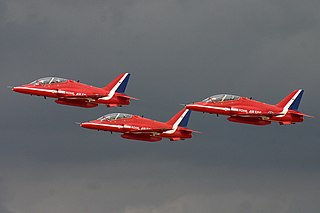
A parachute is a device used to slow the motion of an object through an atmosphere by creating drag. Parachutes are usually made out of light, strong fabric, originally silk, now most commonly nylon. They are typically dome-shaped, but vary, with rectangles, inverted domes, and others found. A variety of loads are attached to parachutes, including people, food, equipment, space capsules, and bombs.

In aircraft, an ejection seat or ejector seat is a system designed to rescue the pilot or other crew of an aircraft in an emergency. In most designs, the seat is propelled out of the aircraft by an explosive charge or rocket motor, carrying the pilot with it. The concept of an ejectable escape crew capsule has also been tried. Once clear of the aircraft, the ejection seat deploys a parachute. Ejection seats are common on certain types of military aircraft.
Martin-Baker Aircraft Co. Ltd. is a British manufacturer of ejection seats and safety-related equipment for aviation. The company's origins were originally as an aircraft manufacturer before becoming a pioneer in the field of ejection seats. The company's headquarters are in Higher Denham, Buckinghamshire, England with other sites in France, Italy and the United States.

The Boulton Paul Defiant is a British interceptor aircraft that served with the Royal Air Force (RAF) during World War II. The Defiant was designed and built by Boulton Paul Aircraft as a "turret fighter", without any fixed forward-firing guns, also found in the Blackburn Roc of the Royal Navy.

The Sukhoi Su-7 is a swept wing, supersonic fighter aircraft developed by the Soviet Union in 1955. Originally, it was designed as a tactical, low-level dogfighter, but was not successful in this role. On the other hand, the soon-introduced Su-7B series became the main Soviet fighter-bomber and ground-attack aircraft of the 1960s. The Su-7 was rugged in its simplicity, but its Lyulka AL-7 engine had such high fuel consumption that it seriously limited the aircraft's payload, as even short-range missions required that at least two hardpoints be used to carry drop tanks rather than ordnance.

The Short Tucano is a two-seat turboprop basic trainer built by Short Brothers in Belfast, Northern Ireland. It is a licence-built version of the Brazilian Embraer EMB 312 Tucano.

The Avioane Craiova IAR-93 Vultur (Vulture) is a twinjet, subsonic, close support, ground attack and tactical reconnaissance aircraft with secondary capability as low level interceptor. Built as single-seat main attack version or combat capable two-seat version for advanced flying and weapon training, it was developed as a joint Yugoslav-Romanian project in the 1970s for the air forces of both nations. The Romanian aircraft were built by I.R.Av. Craiova as IAR-93, and its Yugoslav counterpart by Soko as the Soko J-22 Orao. For Romania, the IAR-93 was intended to replace MiG-15s and MiG-17s in the fighter-bomber role.

The BAC 167 Strikemaster is a British jet-powered training and light attack aircraft. It was a development of the Hunting Jet Provost trainer, itself a jet engined version of the Percival Provost, which originally flew in 1950 with a radial piston engine.

The Saab 18 was a twin-engine bomber and reconnaissance aircraft, designed and built by Svenska Aeroplan AB (SAAB) for use by the Swedish Air Force in response to a 1938 design competition. Due to delays, it did not enter service until 1944, but quickly became the standard Swedish bomber aircraft. Serving in the bomber, reconnaissance and ground-attack roles, it also assisted in the development of ejection seats and air-to-surface guided missiles until its replacement by the Saab Lansen in the late 1950s.
Thunder City is an aircraft operating and maintenance company based at the Cape Town International Airport in Cape Town, South Africa. It was well known for owning the largest civilian collection of former military jet aircraft in the world. These aircraft were used to perform in airshows and could also be chartered by the general public for recreational flights, including going supersonic and climbing to altitudes around 50,000 feet. Following a fatal accident in 2009 in which an English Electric Lightning crashed at an airshow, the company ceased flying operations after the accident investigation found major shortcomings in its maintenance programme.

The Martin-Baker Mk.7 is a British rocket-assisted ejection seat designed and built by Martin-Baker. Introduced in the mid-1960s, the Mk.7 has been installed in combat aircraft worldwide.

The Martin-Baker Mk.6 is a British rocket-assisted ejection seat designed and built by Martin-Baker. Introduced in the 1960s, the Mk.6 has been installed in combat and training aircraft worldwide.

The Martin-Baker Mk.5 is a British ejection seat designed and built by Martin-Baker. Introduced in the late 1950s, the Mk.5 has been installed in combat and training aircraft worldwide.

The Martin-Baker Mk.4 is a British ejection seat designed and built by Martin-Baker. Introduced in the 1950s, the Mk.4 has been installed in combat and training aircraft worldwide.

The Martin-Baker Mk.9 is a British rocket-assisted ejection seat designed and built by Martin-Baker. Introduced in the late-1960s, the zero-zero capable Mk.9 has been installed in several European combat aircraft types and was also used in experimental aircraft.

The Martin-Baker Mk.10 is a British rocket-assisted ejection seat designed and built by Martin-Baker. Introduced in the 1970s, the zero-zero capable Mk.10 has been installed in many combat aircraft types. A lightweight version is known as the Mk.10L.

The Martin-Baker Mk.1 is a British ejection seat designed and built by Martin-Baker. Developed in the late 1940s it was the first in the line of production Martin-Baker seats for military aircraft. Ground and air testing of earlier designs resulted in the first successful test ejection of a company employee in July 1946. A seat type designed for the Saunders-Roe company was known as the Pre-Mk.1.

The UTVA Kobac is a prototype light military trainer aircraft in development by UTVA. It is a single-engine, low-wing tandem-seat turboprop training aircraft with a metal airframe. The aircraft will be capable of higher basic training functions including aerobatics, instrument, tactical flying and it provides an easy transition to jet trainer at higher training levels. And also will be capable of performing close air support, counter insurgency (COIN), and reconnaissance missions. Kobac is Serbian for sparrowhawk.

The Martin-Baker Mk.2 is a British ejection seat designed and built by Martin-Baker. Introduced in the early 1950s, the Mk.2 was developed from the Martin-Baker Mk.1, the main improvement being automatic parachute deployment.

Flight Lieutenant Sean Cunningham was a Royal Air Force pilot on the Red Arrows aerobatics display team, who died when his ejection seat initiated whilst the aircraft he was in was stationary on the ground and he was conducting pre-flight checks. The incident occurred at the Red Arrows' home base, RAF Scampton in Lincolnshire, England. The initiation of the ejection seat was assumed to be by accident. The parachute on the seat did not deploy and Cunningham fell, still strapped to the seat, 220 feet (67 m) to his death 217 feet (66 m) away from the motionless aircraft. In January 2018, in the prosecution brought by the Health and Safety Executive, Martin-Baker, the manufacturers of the seat, pleaded guilty to a breach of health and safety law regarding Cunningham's death. On 23 February 2018, Martin-Baker were fined £1.1 million.


















